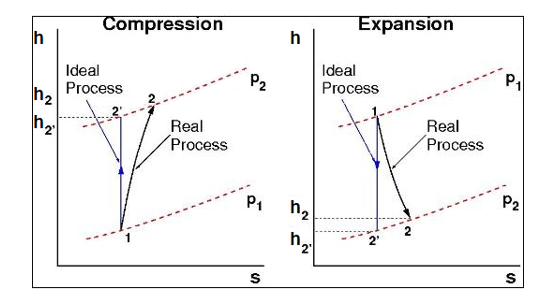The efficiency of any device is never perfect due to both fluid dynamic and thermodynamic losses within the entire system. The losses appear as a difference between actual values from those that would be expected if the process was perfectly isentropic. Consider the processes drawn on the T-s diagrams shown in Figure 25.2: T-s Diagrams for Compression and Expansion Processes.
Three efficiency calculation options are available for either process: Total to Total, Total to Static, and Static to Static.
For an expansion process (for example, in a steam turbine), these options are defined by the following ratios:
(25–40) |
(25–41) |
(25–42) |
where and
are the mass-averaged values of the total enthalpy at points 1 and
2, respectively, and
is the mass-averaged value of the static enthalpy at point 2. In
addition, the isentropic total enthalpy
and isentropic static enthalpy
are required. They are evaluated from the state equation:
(25–43) |
(25–44) |
where the entropy is taken at point 1, by default, as the mass-averaged value,
is the area-averaged value of the static pressure at point 2, and
is the mass-flow averaged value of the total pressure at point
2.
For a compression process (for example, in a gas compressor), the ratios Equation 25–40, Equation 25–41, and Equation 25–42 are inversed and read as:
(25–45) |
(25–46) |
(25–47) |
The Total to Total and Total to Static option are most useful for devices where work is either performed on the fluid (for example, a pump or compressor) or extracted from the fluid (for example, a turbine). The Static to Static option is useful for evaluating losses in devices that perform no work on the fluid (for example, diffusers and nozzles).



